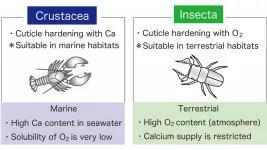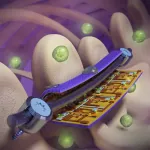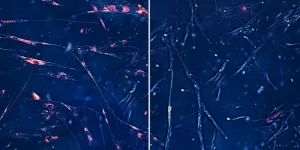(Press-News.org) BIRMINGHAM, Ala. – The immune system has a biological telecommunications system — small proteins known as interleukins that send signals among the leukocyte white blood cells to control their defense against infections or nascent cancer. Interleukin-6, or IL-6, is one of these key mediators of inflammation, and it can, as needed, provoke the immune system into attack against pathogens.
However, imbalances of IL-6 — too much or too little — can cause disease, even in the absence of infection. Excess IL-6 is central to the pathogenesis of inflammatory reactions like rheumatoid disease and cytokine storms, while mutations that interrupt IL-6 signaling are also harmful, causing allergic disorders known as atopy that affect the skin, airways or body, including atopic dermatitis, allergic airway inflammation and hyper-IgE Syndrome, or HIES.
Loss of IL-6 signaling was known to cause an increase in inflammatory T helper 2, or Th2, cells. T helper cells act like generals, ordering other immune cells into action. Now, an unrecognized mechanism of how interrupted IL-6 signaling creates Th2 bias, as well as the specific role of IL-6 signaling in that process, has been described by Beatriz Léon, Ph.D., and colleagues at the University of Alabama at Birmingham. Their study is published in the Nature journal Cellular & Molecular Immunology.
“Understanding how IL-6 contributes to suppress allergic sensitization may offer new strategies to prevent atopic disease in patients with deficient IL-6 signaling,” said Léon, an associate professor in the UAB Department of Microbiology.
The UAB team used a mouse model of allergic airway inflammation, induced by house dust mite allergen, to drive a response where naïve CD4+ T cells differentiate into Th2 cells. In the model, mice received intranasal allergen for three days, and then were again exposed to allergen two weeks later to induce an allergic reaction. In the experiments, researchers used T cells of various genetic backgrounds and also used various biological inhibitors, such as antibodies against interleukins or against interleukin receptors.
Researchers found that IL-6 signaling in allergen-specific T cells was needed to suppress commitment to the harmful Th2 lineage. This mechanism is distinct, but complementary to, a previously described suppression mechanism involving interleukin-12 and the Tbet transcription factor.
The UAB team found that the harmful Th2 cell lineage commitment in their model required strong and prolonged signaling by interleukin-2, or IL-2, in cells unable to make or respond to IL-6. In wild type T cells, IL-6 shuts down IL-2 signaling early in T-cell activation to inhibit Th2 cell priming.
Mechanistically, IL-6 acts to upregulate SOCS3, the Suppression of Cytokine Signaling 3 protein, which is a negative-feedback inhibitor of certain cytokines that bind to receptors on the surface of cells. In the absence of SOCS3, binding of those cytokines activates the JAK/STAT internal signaling pathway that leads to altered gene expression. Cytokines is a general term for signaling proteins that include not only interleukins, but also interferons and growth factors.
SOCS3 is known to inhibit internal signaling by inhibiting the kinase activity of the JAK1 protein. In further support of their mechanism, Léon and colleagues found that a selective inhibitor of JAK1 was able to prevent Th2 cell priming in cells that did not receive IL-6 signaling, showing that IL-6 suppression of the harmful Th2 bias acted through inhibition of the JAK/STAT pathway.
The UAB group also found that IL-6 had to act early — the first two days after T-cell priming with house dust mite allergen — to turn off IL-2 signaling.
“Taken together, our data demonstrate that IL-6 signaling in allergen-specific T cells is essential for preventing Th2 development by counteracting IL-2-driven pro-Th2 signals,” Léon said. “Our data provide insights into the immunological processes behind skewed Th2 responses in patients with defective IL-6 signaling or exposed to environmental factors that lead to decreased IL-6 synthesis.”
First author of the study, “IL-6 prevents Th2 cell polarization by promoting SOCS3-dependent suppression of IL-2 signaling,” is Holly Bachus, UAB Department of Medicine, Division of Clinical Immunology and Rheumatology.
Co-authors with Léon and Bachus are Erin McLaughlin, Crystal Lewis, Dave Durell Hill and Alexander F. Rosenberg, UAB Department of Microbiology; Amber M. Papillion and André Ballesteros-Tato, UAB Department of Medicine, Division of Clinical Immunology and Rheumatology; and Etty N. Benveniste, UAB Department of Cell, Developmental and Integrative Biology.
Support came from UAB and National Institutes of Health grants AI116584, AI150664 and AI162698.
At UAB, the departments of Microbiology, Medicine, and Cell, Developmental and Integrative Biology are part of the Marnix E. Heersink School of Medicine.
END
How interleukin-6 helps prevent allergic asthma and atopy by suppressing interleukin-2 signaling
Knowledge of this previously unrecognized mechanism may aid therapy for patients with interleukin-6 signaling mutations and hyper-IgE Syndrome, or HIES.
2023-05-06
ELSE PRESS RELEASES FROM THIS DATE:
Why are there so few insects in the ocean?
2023-05-06
Tokyo, Japan – Scientists from Tokyo Metropolitan University have proposed a hypothesis for why insects are so rare in marine environments. They previously showed that insects evolved a unique chemical mechanism to harden their shells which uses molecular oxygen and an enzyme called multicopper oxidase-2 (MCO2). Now, they argue that this gives them a disadvantage in the sea, while it confers advantages that help them on land, placing MCO2 at the heart of insect eco-evolution.
Insects are some of the most successful organisms on the planet. ...
Smart surgical implant coatings provide early failure warning while preventing infection
2023-05-05
CHAMPAIGN, Ill. — Newly developed “smart” coatings for surgical orthopedic implants can monitor strain on the devices to provide early warning of implant failures while killing infection-causing bacteria, University of Illinois Urbana-Champaign researchers report. The coatings integrate flexible sensors with a nanostructured antibacterial surface inspired by the wings of dragonflies and cicadas.
In a new study in the journal Science Advances, a multidisciplinary team of researchers found the coatings prevented infection in live mice and mapped strain in commercial implants applied to sheep spines to warn of various implant or healing failures.
“This ...
Artificial intelligence identifies anti-aging drug candidates targeting ‘zombie’ cells
2023-05-05
SAN CARLOS, California – A new publication in the May issue of Nature Aging by researchers from Integrated Biosciences, a biotechnology company combining synthetic biology and machine learning to target aging, demonstrates the power of artificial intelligence (AI) to discover novel senolytic compounds, a class of small molecules under intense study for their ability to suppress age-related processes such as fibrosis, inflammation and cancer. The paper, “Discovering small-molecule senolytics with deep neural networks,” authored in collaboration with ...
How to make the faculty job search less discouraging
2023-05-05
Finding a full-time faculty job can be a daunting challenge for doctoral graduates.
University of Cincinnati anthropologist Kathleen Grogan says postdoctoral researchers can benefit from having peers review their applications.
She learned this herself while working as a postdoctoral researcher. She realized that she and other postdocs routinely solicited feedback in an online messaging app dedicated to aspiring scientists.
“I was on the job market and wanted people with broad scientific expertise to look at my stuff,” said Grogan, an assistant professor in UC’s College ...
Markey Cancer Center earns National Pancreas Foundation Center designation for treatment of pancreatic cancer
2023-05-05
LEXINGTON, Ky. (May 5, 2023) — The University of Kentucky Markey Cancer Center has been recognized by the National Pancreas Foundation (NPF) as an approved NPF Center of Excellence.
The designation is awarded after a rigorous audit review to determine that an institution's focus is on multidisciplinary treatment of pancreatic cancer, treating the “whole patient” with a focus on the best possible outcomes and an improved quality of life.
“We are honored to receive the NPF designation, which highlight’s Markey’s commitment to multidisciplinary ...
Scientists capture elusive chemical reaction using enhanced X-ray method
2023-05-05
Researchers at SLAC National Accelerator Laboratory captured one of the fastest movements of a molecule called ferricyanide for the first time by combining two ultrafast X-ray spectroscopy techniques. They think their approach could help map more complex chemical reactions like oxygen transportation in blood cells or hydrogen production using artificial photosynthesis.
The research team from SLAC, Stanford and other institutions started with what is now a fairly standard technique: They zapped a mixture of ferricyanide and water with an ultraviolet laser and bright X-rays generated by the Linac Coherent Light Source (LCLS) X-ray free-electron laser. ...
Providing legal counsel at initial bail hearings lowers incarceration rates
2023-05-05
Providing defendants with legal counsel during their initial bail hearing decreases use of monetary bail and pretrial detention, without increasing the likelihood that defendants fail to appear at the subsequent preliminary hearing, according to a new RAND Corporation study.
Researchers found that having legal counsel at bail hearings increased the probability of being released without monetary bail by 21% and reduced the probability that an individual was in jail three days after their bail hearing by 10%.
The analysis, based on a field experiment in Pittsburgh where public defenders were assigned to a limited number of initial bail hearings, is ...
Yale study reveals insights into post-vaccine heart inflammation cases
2023-05-05
New Haven, Conn. — When new COVID-19 vaccines were first administered two years ago, public health officials found an increase in cases of myocarditis, an inflammation of the heart muscle, particularly among young males who had been vaccinated with mRNA vaccines. It was unclear, however, what exactly was causing this reaction.
In a new study, Yale scientists have identified the immune signature of these heart inflammation cases.
These findings, published May 5 in the journal Science Immunology, rule out some of the theorized causes of the heart inflammation and suggest potential ways to further ...
nTIDE April 2023 Jobs Report: Despite sharp decline, employment remains above pre-pandemic levels for people with disabilities
2023-05-05
East Hanover, NJ – May 5, 2023 –Declines in the April job numbers for people with disabilities raise concerns about the future of the job market, according to today’s National Trends in Disability Employment – semi-monthly update (nTIDE), issued by Kessler Foundation and the University of New Hampshire’s Institute on Disability (UNH-IOD). To assess whether this change signals a slowing of job gains for people with disabilities, nTIDE experts will look closely at the direction of next month’s employment indicators.
Month-to-Month ...
Systemic AL amyloidosis: Current approach and future direction
2023-05-05
“AL amyloidosis is a fatal disease and systemic therapy is required to prevent deposition of amyloid in other organs and prevent progressive organ failure.”
BUFFALO, NY- May 5, 2023 – A new review paper was published in Oncotarget's Volume 14 on April 26, 2023, entitled, “Systemic AL amyloidosis: current approach and future direction.”
In this review, researchers Maroun Bou Zerdan, Lewis Nasr, Farhan Khalid, Sabine Allam, Youssef Bouferraa, Saba Batool, Muhammad Tayyeb, Shubham Adroja, Mahinbanu Mammadii, Faiz Anwer, Shahzad Raza, and Chakra P. Chaulagain from SUNY Upstate Medical University, University of Texas MD Anderson ...
LAST 30 PRESS RELEASES:
Sport in middle childhood can breed respect for authority in adolescence
From novel therapies to first-in-human trials, City of Hope advances blood cancer care at the American Society of Hematology (ASH) annual conference
Research aims to strengthen the security of in-person voting machines
New study exposes hidden Alzheimer’s 'hot spots' in rural Maryland and what they reveal about America’s growing healthcare divide
ASH 2025: Study connects Agent Orange exposure to earlier and more severe cases of myelodysplastic syndrome
ASH 2025: New data highlights promise of pivekimab sunirine in two aggressive blood cancers
IADR elects George Belibasakis as vice-president
Expanding the search for quantum-ready 2D materials
White paper on leadership opportunities for AI to increase employee value released by University of Phoenix College of Doctoral Studies
ASH 2025: New combination approach aims to make CAR T more durable in lymphoma
‘Ready-made’ T-cell gene therapy tackles ‘incurable’ T-cell leukemia
How brain activity changes throughout the day
Australian scientists reveal new genetic risk for severe macular degeneration
GLP-1 receptor agonists likely have little or no effect on obesity-related cancer risk
Precision immunotherapy to improve sepsis outcomes
Insilico Medicine unveils winter edition of Pharma.AI, accelerating the path to pharmaceutical superintelligence
Study finds most people trust doctors more than AI but see its potential for cancer diagnosis
School reopening during COVID-19 pandemic associated with improvement in children’s mental health
Research alert: Old molecules show promise for fighting resistant strains of COVID-19 virus
Journal of Nuclear Medicine Technology supplement highlights advances in theranostics and opportunities for growth
New paper rocks earthquake science with a clever computational trick
ASH 2025: Milder chemo works for rare, aggressive lymphoma
Olfaction written in bones: New insights into the evolution of the sense of smell in mammals
Engineering simulations rewrite the timeline of the evolution of hearing in mammals
New research links health impacts related to 'forever chemicals' to billions in economic losses
Unified EEG imaging improves mapping for epilepsy surgery
$80 million in donations propels UCI MIND toward world-class center focused on dementia
Illinois research uncovers harvest and nutrient strategies to boost bioenergy profits
How did Bronze Age plague spread? A sheep might solve the mystery
Mental health professionals urged to do their own evaluations of AI-based tools
[Press-News.org] How interleukin-6 helps prevent allergic asthma and atopy by suppressing interleukin-2 signalingKnowledge of this previously unrecognized mechanism may aid therapy for patients with interleukin-6 signaling mutations and hyper-IgE Syndrome, or HIES.







